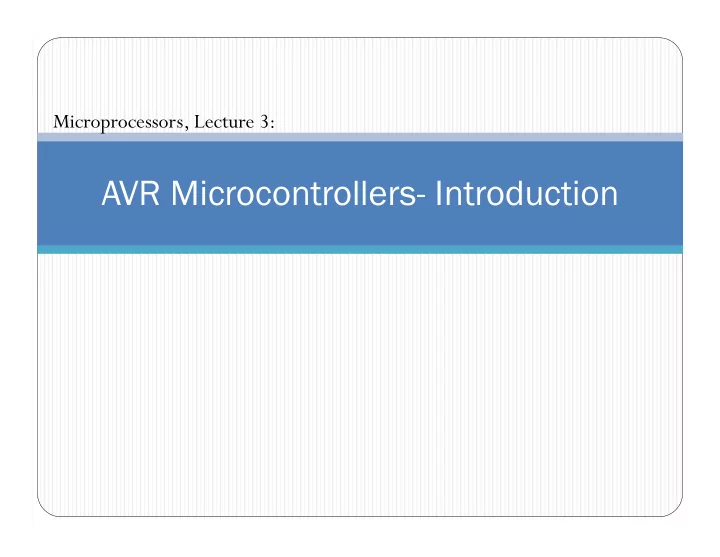

Microprocessors, Lecture 3: AVR Microcontrollers- Introduction
AVR Microcontrollers � Widely-used microcontroller � Different families � Based on the application and Flash memory capacity � Classic AVR � e.g. AT90S2313, AT90S4433 � Mega � e.g. ATmega8, ATmega32, ATmega128 � Tiny � e.g. ATtiny13, ATtiny25 � Special Purpose AVR � e.g. AT90PWM216,AT90USB1287 2
AVR internal architecture RAM EEPROM Timers PROGRAM ROM Program Bus Bus CPU Other Interrupt OSC Ports Peripherals Unit I/O PINS 3 3
AVR’s CPU � CPU: � RISC architecture � 131 instructions � Most instructions are executed in a single cycle � 32 general-purpose registers � 64 IO registers � Many useful peripherals � Very low-power � less than 10mW power consumption 4
AVR’s CPU R0 � AVR’s CPU R1 ALU � ALU R2 � 32 General Purpose registers (R0 … to R31) SREG: H N Z I T S V C R15 CPU � PC register R16 � Instruction decoder R17 � Almost the same for all PC … families R30 Instruction decoder R31 Instruction Register registers 5 5
SREG flags � Not all instructions affect flags � Example: load instruction has nothing to do with flags 6
Decision making by flags 7
Memory address space � A unified address space � 32 general-purpose registers � Directly connected to the ALU � 64 IO registers � To keep the data sent to/ received from peripherals � Stack � Starting from the end of SRAM and grow up to lower addresses � Indexed by SPL-SPH registers 8
Internal busses 9
Some simple instructions 1. Loading values into the general purpose registers LDI (Load Immediate) LDI Rd, k � Its equivalent in high level languages: � Rd = k Example: LDI R16,53 � R16 = 53 � � LDS (Load from SRAM) � LDS R0,0x300 � Load R0 by data from address 300 10 10
Some simple instructions 2. Arithmetic calculation There are some instructions for doing arithmetic and logic � operations; such as: ADD, SUB, MUL, AND, etc. ADD Rd,Rs � Rd = Rd + Rs � Example: � ADD R25, R9 � R25 = R25 + R9 � ADD R17,R30 � R17 = R17 + R30 � 11 11
Some simple instructions 3. store No immediate value store! Just stores can be done through � registers 12 12
Some simple instructions 3. IN and OUT Each IO register can be addressed in two ways: � Memory address � IO address (relative to the beginning of the IO registers) � “IN” and “OUT” use the IO address � example: IN r1,0x16 ;// copy IO register no. 10 (memory � address 0x36 to r1) 13 13
Some other instructions 14
ALU instructions 15
Single operand instructions 16
Directives � Like directives in high level languages � For core readability � Not instructions that generate machine code after compile � Example: EQU � To set a constant value � Equivalent to CONSTANT in C++ 17
Other directives 18
AVR data size � AVR just has 8-bit data � Programmer or compiler has to break larger data into 8-bit units 19
A simple program � Write a program that calculates 19 + 95 LDI R16, 19 ;R16 = 19 LDI R20, 95 ;R20 = 95 ADD R16, R20 ;R16 = R16 + R20 R0 R1 ALU R2 … SREG: I T H S V N Z C CPU R15 R16 R17 PC … R30 Instruction decoder R31 Instruction Register registers 20 20
Code memory � The program after compiling is stored in a ROM (flash memory) � To keep the code even when the system is powered off � Data is stored in another memory (SRAM) � In AVR each code memory location is 2-bytes � In Atmega32, 32K flash memory is organized as 16Kx16 words � Needs 14-bit PC 21
Instruction size � Almost all instructions are 2 bytes � Example: � 1110: machine code for LDI � Kkkk…= imidiate value � dddd= destination register 22
Another example 23
32-bit instructions 24
ATmega32 � 16 MHz clock frequency � 44 pins � 32 KB instruction memory (Flash) � 1KB data memory (EEPROM) � 2048 B data memory (SRAM) � SPI, USART, and I2C serial ports � 3 timers � 8 10-bit ADC channels � Analog comparator � 4 PWM ports � ……. 25
ATMega32 pins � 4 8-bit ports � PA, PB, PC, PD � Multiplexed with other in-outs 26
AVR programming � Assembly: AVR Studio � C: Code Vision 27
Recommend
More recommend